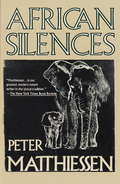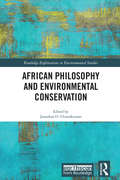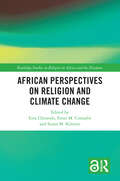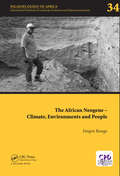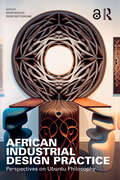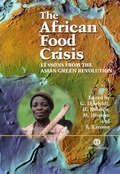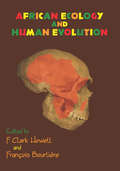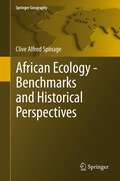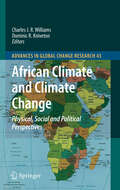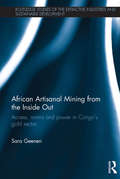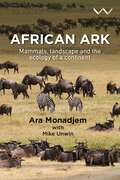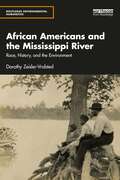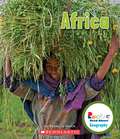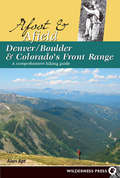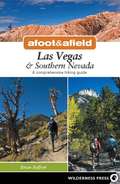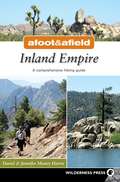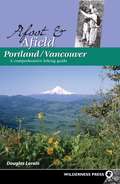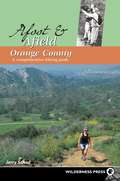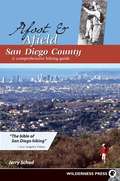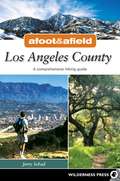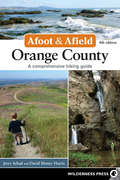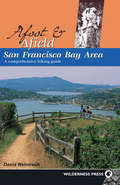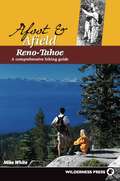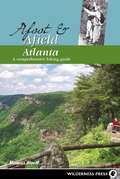- Table View
- List View
African Silences
by Peter MatthiessenAfrican Silences is a powerful and sobering account of the cataclysmic depredation of the African landscape and its wildlife. In this critically acclaimed work Peter Matthiessen explores new terrain on a continent he has written about in two previous books, A Tree Where Man Was Born -- nominated for the National Book Award -- and Sand Rivers.Through his eyes we see elephants, white rhinos, gorillas, and other endangered creatures of the wild. We share the drama of the journeys themselves, including a hazardous crossing of the continent in a light plane. And along the way, we learn of the human lives oppressed by bankrupt political regimes and economies, and threatened by the slow ecological catastrophe to which they have only begun to awaken.
African Philosophy and Environmental Conservation (Routledge Explorations in Environmental Studies)
by Jonathan O. ChimakonamAfrican Philosophy and Environmental Conservation is about the unconcern for, and marginalisation of, the environment in African philosophy. The issue of the environment is still very much neglected by governments, corporate bodies, academics and specifically, philosophers in the sub-Saharan Africa. The entrenched traditional world-views which give a place of privilege to one thing over the other, as for example men over women, is the same attitude that privileges humans over the environment. This culturally embedded orientation makes it difficult for stake holders in Africa to identify and confront the modern day challenges posed by the neglect of the environment. In a continent where deep-rooted cultural and religious practices, as well as widespread ignorance, determine human conduct towards the environment, it becomes difficult to curtail much less overcome the threats to our environment. It shows that to a large extent, the African cultural privileging of men over women and of humans over the environment somewhat exacerbates and makes the environmental crisis on the continent intractable. For example, it raises the challenging puzzle as to why women in Africa are the ones to plant the trees and men are the ones to fell them. Contributors address these salient issues from both theoretical and practical perspectives, demonstrating what African philosophy could do to ameliorate the marginalisation which the theme of environment suffers on the continent. Philosophy is supposed to teach us how to lead the good life in all its forms; why is it failing in this duty in Africa specifically where the issue of environment is concerned? This book which trail-blazes the field of African Philosophy and Environmental Ethics will be of great interest to students and scholars of Philosophy, African philosophy, Environmental Ethics and Gender Studies.
African Perspectives on Religion and Climate Change (Routledge Studies on Religion in Africa and the Diaspora)
by Ezra Chitando, Ernst M. Conradie and Susan M. KilonzoThis book interrogates the contributions that religious traditions have made to climate change discussions within Africa, whether positive or negative. Drawing on a range of African contexts and religious traditions, the book provides concrete suggestions on how individuals and communities of faith must act in order to address the challenge of climate change. Despite the fact that Africa has contributed relatively little to historic carbon emissions, the continent will be affected disproportionally by the increasing impact of anthropogenic climate change. Contributors to this book provide a range of rich case studies to investigate how religious traditions such as Christianity, Hinduism, Islam, and indigenous faiths influence the worldviews and actions of their adherents. The chapters also interrogate how the moral authority and leadership provided by religion can be used to respond and adapt to the challenges posed by climate change. Topics covered include risk reduction and resilience, youth movements, indigenous knowledge systems, environmental degradation, gender perspectives, ecological theories, and climate change financing. This book will be of interest to scholars in diverse fields, including religious studies, sociology, political science, climate change and environmental humanities. It may also benefit practitioners involved in solving community challenges related to climate change.
The African Neogene - Climate, Environments and People: Palaeoecology of Africa 34 (Palaeoecology of Africa #34)
by Jürgen RungeDuring the Neogene – covering the last 23 Million years – the evolution of the environmental setting in Africa was subject to considerable changes. Natural shifts, slow and rapid, evidenced by modifications in palaeogeography, geodynamics, climate, and vegetation have caused repeated and strong changes of ecosystems in the lower latitudes. Using a variety of proxy data – researched and applied by many authors from numerous disciplines – an attempt is made to reconstruct African landscapes over space and time. Besides such spatio-temporal oscillations in recently humid, semi-humid, and dry areas of Africa, this volume of Palaeoecology of Africa (PoA) focuses on long term interrelationships between ecosystem dynamics and climate change, not ignoring the ever growing and ongoing influence of humans on natural ecosystems since the Quaternary. Regionally, this volume lays a strong focus on Nigeria (Niger Delta). Facing the omnipresent challenges of Global Change, an increasing number of African scientists is involved in palaeoenvironmental and palaeoclimatic research, both theoretical and applied. PoA systematically supports established as well as junior African scientists in the field of sustainable cooperation and academic capacity building. This book will be of interest to all concerned with or interested in up-to-date research on Neogene to Quaternary low latitudes ecosystem changes and their respective interpretation in the framework of natural climate and vegetation change evidenced by a variety of methods that allow to read and learn from the past by following the motto, "The geologic foretime as the key to the present, and possibly to the future." Palynologists, Geologists, Geographers, Archaeologists, and Geomorphologists will find this edition equally useful for their work.
African Industrial Design Practice: Perspectives on Ubuntu Philosophy
by Richie Moalosi Yaone RapitsenyaneThe underlying principle of this book is the African philosophy of Ubuntu, which acts as a guide for developing empathic products and services. The book makes the case that empathy is the key to any successful product and service design project because it enables designers to make wise design choices that align with users' demands. Fifteen chapters provide the latest industrial design developments, techniques, and processes explicitly targeting emerging economies. At the outset, it covers the design context and the philosophy of the Ubuntu approach, which places people and communities at the centre of the development agenda. The book covers new product development, design research, design cognition, digital and traditional prototyping, bringing products to the market, establishing a company's brand name, intellectual property rights, traditional knowledge, and the business case for design in Afrika. It concludes with a discussion about the future of design and the skills aspiring designers will need. African Industrial Design Practice: Perspectives on Ubuntu Philosophy will be an essential textbook for undergraduates, postgraduates, instructors, and beginner designers in emerging economies to provide regionally contextualised design processes, illustrated examples, and outcomes.
African Industrial Design Practice: Perspectives on Ubuntu Philosophy
by Richie Moalosi Yaone RapitsenyaneThe underlying principle of this book is the African philosophy of Ubuntu, which acts as a guide for developing empathic products and services. The book makes the case that empathy is the key to any successful product and service design project because it enables designers to make wise design choices that align with users' demands.Fifteen chapters provide the latest industrial design developments, techniques, and processes explicitly targeting emerging economies. At the outset, it covers the design context and the philosophy of the Ubuntu approach, which places people and communities at the centre of the development agenda. The book covers new product development, design research, design cognition, digital and traditional prototyping, bringing products to the market, establishing a company's brand name, intellectual property rights, traditional knowledge, and the business case for design in Afrika. It concludes with a discussion about the future of design and the skills aspiring designers will need.African Industrial Design Practice: Perspectives on Ubuntu Philosophy will be an essential textbook for undergraduates, postgraduates, instructors, and beginner designers in emerging economies to provide regionally contextualised design processes, illustrated examples, and outcomes.Chapter 2 of this book is freely available as a downloadable Open Access PDF at http://www.taylorfrancis.com under a Creative Commons Attribution-Non Commercial-No Derivatives (CC-BY-NC-ND) 4.0 license.
The African Food Crisis: Lessons from the Asian Green Revolution
by Goran Djurfeldt Magnus Jirstroml Rolf Larsson Hans HolmenThe goal of the research project resulting in this monograph was the systematic comparison between Asian agricultural development during the "Green Revolution" and the current agricultural situation in sub-Saharan Africa. The editors (from Sweden's U. of Lund and Link ping U.) include 14 papers that present and analyze macro- level data about national agricultural trends before, during, and after Structural Adjustment Programs and household-level survey data for comparison of countries. The analysis is geared towards investigating agro ecological, demographic, and technological obstacles to African agricultural development; the possible contributions of African smallholders to food security; the likely impact of market integration of small-scale integration on economic and ecological crisis; the inadequacy of export-oriented policies to meeting the demands of food security; and the relevance of the Asian model for Africa. Distributed in the US by Oxford U. Press. Annotation ©2005 Book News, Inc., Portland, OR (book news.com)
African Ecology and Human Evolution
by F. Clark Howell Francois BourliereThe record of man's early evolution, though still fragmentary, is more complete on the African continent than anywhere else in the world. The ecological context of this evolution, however, has been studied intensively only in recent years. This pioneering volume draws together eminent specialists from many fields--physical anthropologists, zoologists, geologists, paleontologists, and prehistorians--who summarize here the results of their diverse research on Pleistocene environments and the cultural and biological evolution of man in Africa.This volume was sponsored by the Wenner-Gren Foundation for Anthropological Research Inc., which met at Burg Wartenstein, Austria. The editors have field experience in Africa, especially eastern and equatorial Africa. This experience is coupled with their awareness of the need to integrate results of numerous field studies bearing on the biological-behavioral evolution of higher primates with other field studies on the paleoecology and the mammalian ecology of sub-Saharan Africa.The book includes contributions on Pleistocene stratigraphy and climatic changes throughout the African continent; on the origin and evolution of the earliest man-like creatures in Africa; on the dating, distribution, and adaptation of Pleistocene hunter-gatherer peoples; and on the ecology, biology, and social behavior of African primate and human populations. The chapters reflect vividly the state of current knowledge at the time and indicate paths for future research. Over 100 maps and figures, detailed bibliographies, and a comprehensive index contribute to the importance of the volume for basic reference use.
African Ecology: Benchmarks and Historical Perspectives (Springer Geography)
by Clive Alfred SpinageIn view of the rapidly changing ecology of Africa ,this work provides benchmarks for some of the major, and more neglected, aspects, with an accent on historical data to enable habitats to be seen in relation to their previous state, forming a background reference work to understanding how the ecology of Africa has been shaped by its past. Reviewing historical data wherever possible it adopts an holistic view treating man as well as animals, with accent on diseases both human and animal which have been a potent force in shaping Africa's ecology, a role neglected in ecological studies.
African Climate and Climate Change: Physical, Social and Political Perspectives (Advances in Global Change Research #43)
by Charles J. Williams Dominic R. KnivetonCompared to many other regions of the world, Africa is particularly vulnerable to the effects of climate change and variability. Widespread poverty, an extensive disease burden and pockets of political instability across the continent has resulted in a low resilience and limited adaptative capacity of African society to climate related shocks and stresses. To compound this vulnerability, there remains large knowledge gaps on African climate, manifestations of future climate change and variability for the region and the associated problems of climate change impacts. Research on the subject of African climate change requires an interdisciplinary approach linking studies of environmental, political and socio-economic spheres. In this book we use different case studies on climate change and variability in Africa to illustrate different approaches to the study of climate change in Africa from across the spectrum of physical, social and political sciences. In doing so we attempt to highlight a toolbox of methodologies (along with their limitations and advantages) that may be used to further the understanding of the impacts of climate change in Africa and thus help form the basis for strategies to negate the negative implications of climate change on society.
African Artisanal Mining from the Inside Out: Access, norms and power in Congo’s gold sector (Routledge Studies of the Extractive Industries and Sustainable Development)
by Sara GeenenArtisanal mining is commonly associated with violent conflict, rampant corruption and desperate poverty. Yet millions of people across Sub Sahara Africa depend on it. Many of them are living in eastern Democratic Republic of Congo (DRC), home to important mineral reserves, but also to a plethora of armed groups and massive human rights violations. African Artisanal Mining from the Inside Out provides a rich and in-depth analysis of the Congolese gold sector. Instead of portraying miners and traders as passive victims of economic forces, regional conflicts or disheartening national policies, it focuses on how they gain access to and benefit from gold. It shows a professional artisanal mining sector governed by a set of specific norms, offering ample opportunities for flexible employment and local livelihood support and being well-connected to the local economy and society. It argues for the viability of artisanal gold mining in the context of weak African states and in the transition towards a post-conflict and more industrialized economy. This book will be of great interest to researchers and postgraduates studying natural resources and development as well as those in development studies, African studies, sociology, political economy, political ecology, legal pluralism, and history.
African Ark: Mammals, landscape and the ecology of a continent
by Dr. Ara MonadjemThe story of how Africa’s mammals have helped shape the continent’s landscapes over time to support an amazing diversity of lifeAfrica is home to an amazing array of animals, including the world’s most diverse assortment of large mammals. These include the world’s largest terrestrial mammal, the African elephant, which still roams great swathes of the continent alongside a host of other well-known large mammals with hooves such as hippopotamuses, giraffes, rhinoceroses, and zebras. African Ark: Mammals, Landscape and the Ecology of a Continent tells the story of where these mammals have come from and how they have interacted to create the richly varied landscape that makes up Africa as we know it today. It gives an equal airing to small mammals, such as rodents and bats, which are often overlooked by both naturalists and zoologists in favor of their larger cousins. African Ark not only describes the diversity of African mammals and the habitats in which they live; it also explains the processes by which species and population groups are formed and how these fluctuate over time. A book on mammals would not be complete without attention placed on the impact of megafauna on the environment and the important roles they play in shaping the landscape. In this way, mammals such as elephants and rhinoceros support countless plant communities and the habitats of many smaller animals. The book brings in a human perspective as well as a conservation angle in its assessment of the interaction of African mammals with the people who live alongside them. African Ark is at once scientifically rigorous and accessible for the layperson and student alike, while drawing on the contributions of numerous zoologists, ecologists and conservationists dedicated to the understanding of Africa and its wildlife.
African Americans and the Mississippi River: Race, History, and the Environment (Routledge Environmental Humanities)
by Dorothy Zeisler-VralstedThis book follows the historical trajectory of African Americans and their relationship with the Mississippi River dating back to the 1700s and ending with Hurricane Katrina and the still-contested Delta landscape. Long touted in literary and historical works, the Mississippi River remains an iconic presence in the American landscape. Whether referred to as "Old Man River" or the "Big Muddy," the Mississippi River represents imageries ranging from the pastoral and Acadian to turbulent and unpredictable. However, these imageries—revealed through the cultural production of artists, writers, poets, musicians, and even filmmakers—did not reflect the experiences of everyone living and working along the river. Missing is a broader discourse of the African American community and the Mississippi River. Through the experiences of African Americans with the Mississippi River, which included narratives of labor (free and enslaved), refuge, floods, and migration, a different history of the river and its environs emerges. The book brings multiple perspectives together to explore this rich history of the Mississippi River through the intersection of race and class with the environment. The text will be of great interest to students and researchers in environmental humanities, including environmental justice studies, ethnic studies, and US and African American history.
Africa (Rookie Read-About Geography)
by Rebecca E. Hirsch<p>Get ready for a fascinating trip around the seven continents of the world! Simple, engaging text and colorful, mesmerizing pictures teach you about each continent's land features, populations, native animals, technological advances, and lots more—including how to find each continent on a map! <p>Africa is a large and diverse continent, and young readers will love discovering the people, geography, and animals found there.</p>
Afoot and Afield: Denver/Boulder and Colorado's Front Range
by Alan AptThis guidebook takes hikers throughout the Colorado Rocky Mountains and their foothills, rivers, and plains. Featuring more than 200 trips, from trails near the state's Wyoming border to Pikes Peak near Colorado Springs, author Alan Apt maps out hikes both long and short, exploring trails accessible from Denver, Boulder, and other Front Range communities. Each hike has it's own map, and includes essential at-a-glance info as well as additional trail-use data such as which trails are suitable for children, dogs, horseback riding, and mountain bikes.
Afoot and Afield: Las Vegas and Southern Nevada
by Brian BeffortBeyond the bright lights of one of the city's fastest growing metropolitan areas is some of the most rugged, beautiful, and remote country around. Popular destinations such as Red Rock Canyon, Valley of Fire, Death Valley, and Mt. Charles are covered, plus lesser-known areas such as Anniversary Narrows, Arrow Canyon, Bowl of Fire, and the Wee Thump Joshua Tree Wilderness. Each trip showcases the diversity of this region, from the geological wonders and rare life forms surviving in Mojave National Preserve to ancient petroglyphs. The hikes range from easy strolls to challenging treks and include distance, time, elevation change, difficulty, and trail-use notes. A custom map accompanies every description, and GPS waypoints are given for key locations.
Afoot and Afield: Inland Empire
by Jennifer Money Harris David Money HarrisThe Inland Empire-the area east of Los Angeles and located primarily in San Bernardino and Riverside counties-is known as Southern California's big backyard. And with its mountain, foothill, valley, and desert recreational opportunities, it's a hiker's paradise. Afoot & Afield Inland Empire describes nearly 200 noteworthy hikes ranging from easy to very strenuous in this first comprehensive hiking guide to the length and breadth of Inland Empire. These hikes explore Southern California's three tallest mountains, the stark beauty of the high desert, including Joshua Tree National Park and Mojave National Preserve, as well as trails that wind through urban and regional parks. Each hike is shown on custom-created maps that also include GPS waypoints: the maps alone are worth the price of the book.
Afoot and Afield: Portland/Vancouver
by Douglas LorainIn nearly 200 trips Afoot & Afield Portland/Vancouver covers every hike within a one-hour drive of this metropolitan area. Hit the trail through dense old-growth forests, walk beside waterfalls, climb to viewpoints above massive glaciers, or wander through the quiet forests of a 5000-acre park in metro Portland itself. The hikes range from simple strolls through urban preserves to rugged climbs in the Columbia River Gorge and on glacier-clad Mt. Hood. Hikes that are great in cloudy weather are labeled, and each hike is shown on an up-to-date map. Each hike includes at-a-glance essential information - distance, time, elevation change, and difficulty rating.
Afoot and Afield: Orange County
by Jerry SchadThis completely updated and expanded new edition in the Afoot & Afield series is the ultimate guide to the hiking opportunities throughout Southern California's Orange County. Featuring 87 trips from serene summits to sparkling beaches, Afoot & Afield Orange County covers the Laguna Coast, Newport Beach, Crystal Cove State Park, the Chino Hills, Santa Rosa Plateau Ecological Reserve, the Santa Ana Mountains, and more. Trips ranging from short strolls to rigorous daylong treks are all within a short car trip of the Southland's cities.
Afoot and Afield: San Diego County
by Jerry SchadThe Los Angeles Times has hailed Southern California' hiking guru Jerry Schad's Afoot & Afield San Diego County as "the bible of San Diego hiking." Encompassing the county from Sunset Cliff Park and the Bayside Trail at Point Loma to Fonts Point in the Borrego Badlands, this hiking guide is the "must-have" to explore San Diego's diverse outdoors. The book covers all the worthwhile hiking destinations throughout the county - including the coast, foothills, mountains, and desert - in trips ranging from the short family excursions to multi-day backpacks. This long-awaited fourth edition of San Diego County's most recognized and comprehensive hiking guide has been fully updated and expanded to cover 250 hikes. All new maps.
Afoot and Afield: Los Angeles County
by Jerry SchadJerry Schad is your knowledgeable and reliable guide for the 192 trips in this book--ranging from gentle family walks in Griffith Park to strenuous treks over the spine of the San Gabriel Mountains. Whether you see solace from the crowds, a cardiovascular workout, or a new perspective of the natural world around you, this book provides all you need to know.The second edition of this popular book covers all of the county's open spaces. A total of 192 hikes-including 17 new ones-are described in detail with trips organized into specific areas. Illustrated; detailed maps.
Afoot and Afield: Orange County
by Jerry Schad David Money HarrisThis completely updated and expanded new edition in the Afoot and Afield series is the classic guide to the hiking opportunities throughout Southern California's Orange County. Featuring more than 100 trips from serene summits to sparkling beaches, Afoot and Afield Orange County covers the Laguna Coast, Newport Beach, Crystal Cove State Park, the Chino Hills, Santa Rosa Plateau Ecological Reserve, the Santa Ana Mountains, and more. Trips ranging from short strolls to rigorous daylong treks are all within a short car trip of the Southland's cities. Every trip was re-hiked by coauthor David Money Harris for this updated edition.
Afoot and Afield: San Francisco Bay Area
by David WeintraubThis title in the acclaimed Afoot & Afield series contains more than 100 carefully described trips in the nine-county region. Included are all the well-known favorites: Mt. Tamalpais, Point Reyes National Seashore, Henry W. Coe and Mt. Diablo state parks, and Rancho San Antonio Open Space Preserve. The book also features more remote parks and preserves, from the rugged Sonoma coast to hidden canyons south of San Jose, as well as regional open spaces and country parks from the East Bay hills to the Santa Cruz Mountains.
Afoot and Afield: Reno-Tahoe
by Mike WhiteThis title in Wilderness Press's successful Afoot & Afield series is the most comprehensive outdoor guide to the vast backcountry surrounding Reno and Lake Tahoe. This guide features more than 150 trips in the Reno and Lake Tahoe region, including Graeagle, Truckee, Echo Summit, Mt. Rose, and Carson Valley. Trips range from easy strolls to challenging treks and include distance, time, elevation gain, difficulty, and trail notes.
Afoot and Afield: Atlanta
by Marcus WoolfCovers the abundance of natural areas within a two-hour drive of the city in 100 hikes, from challenging backcountry treks in the north Georgia mountains to easy dayhikes along the Chattahoochee River. The diverse trails pass through parks where families can observe wildlife, historical sites and old battlefields, and one of the largest wilderness areas in the Southeast. Highlights summarize each trip's best features, and at-a-glance essential information-distance, time, elevation change, and difficulty rating-makes it easy to choose the right outing. Maps with GPS waypoints indicate notable spots on the trail such as junctions, scenic overlooks, wildlife observation platforms, and backcountry campsites.
